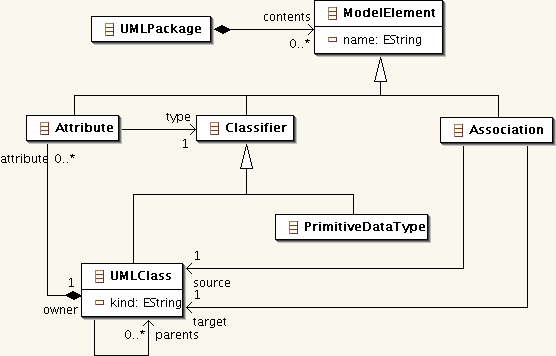Tefkat Tutorial
The EMF Transformation Engine
Prerequisites
Getting Started
- Bring up the new project dialog.

-
Expand "Simple" and select "Project". Click the "Next" button.

-
Give the project a name, say, "transformation". Click the "Finish"
button.

-
Bring up the new folder dialog.

-
Name the folder then click the "Finish" button.
Repeat for the "instances" and "transformations" folders.

Creating Meta-Models
- Create "simpleuml.ecore" corresponding to:

- Create "relational.ecore" corresponding to:

Creating source instance
simpleuml1.xmiCreating a simple transformation specification
This version, "uml2rel2.qvt", is the same transformation but using the alternate
TRANSFORMATION uml2rel : uml -> rel
NAMESPACE http://simpleuml
NAMESPACE http://relational
// Produces a Table and Key for each persistent UMLClass.
//
RULE Class2Table(c, t, k)
FORALL UMLClass c
WHERE c.kind = "persistent"
MAKE Table t, Key k
SET t.name = c.name, t.key = k,
k.name = c.name
;
// Produces Columns belonging to a Table for
// each persistent UMLClass with storable Attributes.
//
RULE Attr2Column(c, a, t, k, col)
EXTENDS Class2Table(c, t, k)
FORALL Attribute a
WHERE hasAttr(c, a, n)
MAKE Column col FROM c4a(c,a,n)
SET col.name = n,
t.column = col
;
// Immediate Attributes of a UMLClass that are primary have
// their corresponding Column as part of the Table's Key.
//
ABSTRACT
RULE KeyColumns(c, a, t, k, col)
EXTENDS Attr2Column(c, a, t, k, col)
WHERE a.kind = "primary" AND
inhAttr(c, a)
SET col.belongsTo = k
;
// An Attribute is "storable" if it is a simple type (PrimitiveDataType),
// or it is UMLClass-valued and that UMLClass is persistent.
//
PATTERN storable(A)
FORALL Attribute A
WHERE
C = A.type AND
(
PrimitiveDataType C
OR
(UMLClass C AND A.type.kind = "persistent")
)
;
// A UMLClass "inherits" an Attribute if it owns it directly,
// or it has a superclass that "inherits" the Attribute.
//
// [Note - other's mapping examples ignore this, but what is a
// "class" model without inheritance?]
//
PATTERN inhAttr(C, A)
FORALL UMLClass C, Attribute A, UMLClass C2
WHERE
A.owner = C
OR
(C.parents = C2 AND inhAttr(C2, A))
;
// This pattern is used to handle so-called "complex types".
// A UMLClass "has" and Attribute with a fully qualified name
// if it "inherits" the attribute and the attribute is storable,
// or it "inherits" another UMLClass-valued attribute for which the
// UMLClass is not persistent (ie a complex type) and that UMLClass
// "has" the attribute.
//
// This will cycle if two non-persistent UMLClasses transitively
// reference each other.
//
PATTERN hasAttr(C, A, N)
FORALL UMLClass C, Attribute A
WHERE
(
inhAttr(C, A) AND
storable(A) AND
A.name = N
)
OR
(
inhAttr(C, A2) AND
A2.type = C2 AND
UMLClass C2 AND
C2.kind != "persistent" AND
hasAttr(C2, A, N2) AND
N = append(A2.name, append("_", N2))
)
;
Register Meta-Models
- Open Eclipse's Preferences and select "Tefkat".
- Click "Add".
- Enter the source meta-model's URI (http://simpleuml) in the "URI Source" field and the corresponding file's URI (platform:/resource/transformation/models/simpleuml.ecore) in the "URI Target" field.
- Repeat for the target meta-model.

Configuring a Transformation
- Right-click on the project and select "New>Other..."
- In "Example EMF Model Creation Wizards" select "TefkatConfig model" and click "Next".

- Enter the filename a click "Next".

- In the drop-down for "Model Object" select "Configuration" then click "Finish". The new document shoud open automatically.

- Click on the disclosure triangle to expose the "Configuration"
element.

- Right-click on the "Configuration" element and select "New Child" ->
"Transformation Task".

- Right-click on the "Transformation Task" element and select "New Child" ->
"Transformation Model".
Repeat for "Source Models Model", and "Target Models Model".

- Right-click on the "Transformation Task" element and select "Show
Properties View".

- Select each of "transformation", "sourceModels", and "targetModels",
and set their values appropriately in the
"Properties View". (Leave the "Var Group" property unset.)

- Select the "Transformation Task" element and change the value of the
"Enabled" property from "false" to "true".

- Save the document "uml2rel.tefkatconfig".
Running a Transformation
- In the "Run" menu, open the Run dialog.

- Select "Tefkat" and create a new launch configuration.

- Click "Browse..." and naviagte to then choose the previously created Tefkat configuration file, "uml2rel.tefkatconfig".

- Click "OK" and then click "Run".
